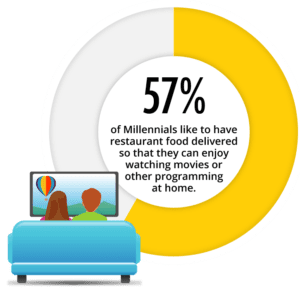What better way to end a day than by slipping into comfy clothes, knowing that a delicious meal someone else cooked is on its way to your home. The demand for this experience is why food delivery apps are big business. At one time, home delivery meant pizza or Chinese food, but the menu has changed dramatically. Today, ‘eating in’ include every choice of cuisine, all of it delivered to your doorstep hot, fresh, and ready to eat.
For consumers, it’s about convenience; for restaurateurs and others in food service, it’s often about survival. As more delivery apps enter the market, there are inevitable stumbles and lessons to be learned.
Questions remain about the future state of food apps, so we will instead focus on the current lay of the land and the trends that are shaping this growing industry.
Note 1: Online food ordering and third-party delivery apps are on the rise.

This industry was already growing even before the pandemic; the emergence of the virus put growth into overdrive. Last spring, Uber Eats was not only the top-downloaded food delivery app worldwide, but it also accounted for a staggering number of total downloads per country: “The countries with the most installs of the app during this period were Japan with 21% of total downloads and the United States at 18.7%.”
Lest you attribute this spike to Covid-19, usage numbers document a trend that has grown over the past few years:
● 10% of Americans use a food delivery service at least once a week
● Consumers spend upwards of $30 billion on U.S. restaurant deliveries each year
● The U.S. food delivery market has enjoyed 20.2% year-on-year growth
The bottom line: if you operate a successful food delivery app, you will likely enjoy this trend for some time to come. The more effectively you do it, the more leverage you will have to realize a profit.
Note 2: Growth in food-delivery apps is driven by a variety of factors.

The most prominent reason is generational: 57% of Millennials like to have restaurant food delivered so that they can enjoy watching movies or other programming at home. The old sales saying is “fish where the fish are,” and with this age group being the bulk of the consumer market, the bulk of the advertising will be aimed at this audience.
The second key reason is the most obvious: the convenience of restaurant-quality meals without driving to a restaurant. This factor transcends age groups; every consumer group can appreciate comfort and convenience. The lingering question is if the habit that has been gradually developed will linger once the pandemic is passed. Habits tend to be stubborn things, especially patterns that make us happy.
Note 3: Customers have expressed likes and dislikes surrounding delivery apps.

About 9 out of 10 food-delivery service users say apps make their lives easier, but that does not mean there are no frustrations or problems. Customer reviews are all over the place, with the top complaint being that the food is not always in peak conditions when delivered, especially when a third-party app is involved.
People have this way of wanting food to be served warm, fresh, and on-time – especially when they’re paying a premium for the service. (U.S. Foods)
Other complaints include:
● Long waits
● High delivery service fees
● Lack of clear communication
● Receiving the wrong order
● Inconsistent prices
● Limited menus
At the same time, customers appreciate efficient service and are willing to pay and tip well when their expectations are met.
Note 4: Outsourcing customer support can help food-delivery apps grow faster.

At first bite, outsourcing customer support may sound as if it would depersonalize delivery and possibly alienate customers, but that is not true. If anything, outsourcing customer support means using a support specialist while focusing on what you do best: providing delicious meals that consumers will continue ordering.
A well-trained, third-party managing your customer support frees up your time for:
● Scaling your support to keep up with growth
● Avoiding the cost of expensive support technologies
● Channeling your resources (space, hiring procedures, and training sessions) directly into the work itself
Please note: outsourcing customer support is not about saving money, though that is often the case. The value is realized in time and energy. When your team can focus on its area of expertise, you can leverage that focus into exponential growth.
Partner with GlowTouch
To maintain a smooth-running delivery app, there are many factors to consider, not the least of which is customer support. By building systems that efficiently, quickly, and reliably support customers, you increase satisfaction in a service your clients already love.
At GlowTouch, we have built a long-standing reputation by providing world-class customer support outsourcing solutions to a wide range of clients. We will help you stay current on the trends and grow your business. To see if the time is right to outsource customer support and to learn more about how you can manage a seamless transition, give us a look. The friendly team of experts at GlowTouch is standing by. Schedule a free consultation and get the ball rolling today.

















































